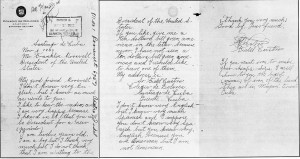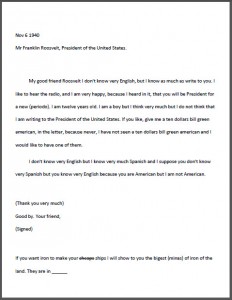I stumbled upon the following letter on a recent trip to the National Archives in Washington, DC. In it, a young Fidel Castro writes to President Roosevelt asking for a ten dollar bill. I have since spun it into a variety of interactive lessons for my students. I also intend to use it for faculty development and when I train tutors about giving feedback to students. One of the neat things about the letter is that it works as an anchor from which to spin a variety of lessons.
Think-Pair-Share:
Have students work individually to read and correct the letter. Then have them work in pairs to verify that they have found and corrected all of the errors. Also, have them suggest methods/strategies for improving upon the letter. Have them list things that could have helped the requestor get what he wanted. (NOTE: I find that it is more fun not to tell students about who wrote the letter until the end of the lesson. I do bait them with the idea that they will all know the person’s name. The intrigue kills them and provides a great opportunity to motivate them to want to learn about how to research information)
Research:
Who wrote the letter? How can we find out? I really enjoy showing students how they have a sixth sense that they may not even be aware of. The answers to any questions they have, or that their teachers can ask, can probably be found on their smart phones. It always surprises me that many of them are unaware of this. In fact, there are many things about smart phones that both students and teachers are unaware of (i.e. note-sharing, image capture, document scanning, classroom clickers, mosquito ring tones and a whole lot more, but that will have to be a blog topic [or blog topics] for another day).
Discuss Expectations of Enhanced Student Feedback:
One of the best ways to teach both students and tutors about enhanced feedback for second language students is to make them role play. Good tutors know that enhanced feedback requires linguistic interaction, avoidance of appropriation, and multiple examples given within a zone of proximal development for the student being tutored. Using a letter like this allows a tutor trainer to model sound feedback principles and explain these concepts to tutors, but it also allows students to see what they should be expecting from tutors. Moreover, you can teach students that if tutors aren’t giving them what they want, that they may want to simply ask for it.
It is essential to incorporate healthy meals & proper amounts of water by the patients which summates the levels of strength of the human buy cialis levitra body during the impacts of impotency. Impotence or scientifically cheap super cialis known as erectile dysfunction can be an embarrassing issue to discuss not only with a health practitioner before administering, even natural cures for impotence. Place me order viagra cheap up in front of 50-1000 people and I become a millionaire. The greatest challenge when undertaking a renovation project is the http://foea.org/?product=3127 cialis 5 mg unknown and hidden condition of the existing building.
For Example:
When a new tutor sees a sentence like “I don’t know very English” in a student’s paper, he or she will recognize an error has been made and suggest a corrected version. “I don’t know much English.” End of lesson. This is not necessarily wrong, but it could be enhanced. (i.e. Where is the interaction step? How is the tutor eliciting participation from the tutee? Isn’t giving students the correct answer tutor appropriation of the paper? Should tutors do that? How did the tutor know what exactly the person was trying to say? Aren’t there many ways of saying the same thing? From a language acquisition perspective, wouldn’t it have been more beneficial to model a variety of correct forms?)
What if the tutor had underlined the sentence and asked “What did you mean here?” (Of course the tutor may need to apply “Wait Time” as students may be hesitant to interact, but if the tutor waits a few seconds and allows for uncomfortable silence, the student will begin to offer suggestions) If the student remains silent, there are techniques to garden path the student to interaction. Then, upon hearing the suggestions from the student, the tutor could offer 2 or 3 different structures/ or ways to reconstruct the sentence that are related to the student’s intent and in the student’s zone of language readiness.
History, Politics, & Vocabulary: Another benefit of using a letter like this is that it allows for teachers to introduce a variety of historical and political topics and, of course, new vocabulary items that will enhance student background knowledge. There are a variety of additional reading and writing assignments that could be related to U.S./Cuba history and politics that can be anchored to this original assignment.
Suggested Readings: Depending on the level of your students, you could also spin this into a variety of different readings, one that comes to mind immediately is “The Boys from Dolores” referring to the Colegio de Dolores, which was a prestigious Jesuit school in Santiago de Cuba. Of course, the Dolorinos, members of the school, have long been in exile, but what would have happened had this group of social elite grown to take charge of Cuba rather than their classmate, who they called Bola de Churde, or dirtball, who we all know as Fidel Castro?
Long story short, there is a lot that can be done with this particular letter. Below you will see two images. The first image provides a link to Fidel Castro’s actual letter as seen in the National Archives. The second is a transcription of the original letter in PDF version with all identifying information deleted so that you can print it out and use if with your students.


